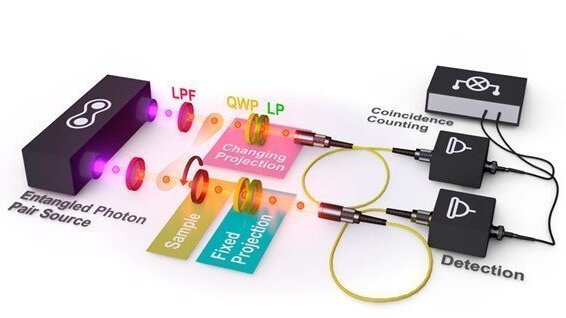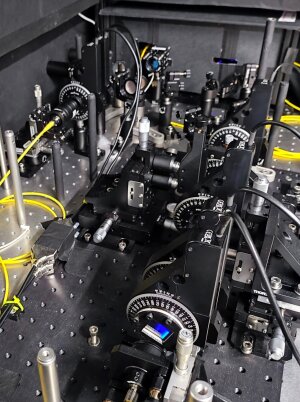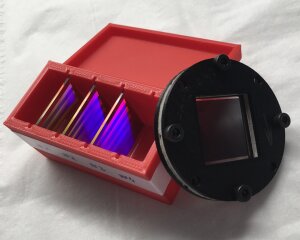
- Light
Published: | By: Ira Winkler, Vira Besaga
Source article
Experimental setup
Image: Vira BesagaA pioneering study from the Institute of Applied Physics at the University of Jena, “Nonlocal quantum differentiation between polarization objects using entanglement”External link by Dr. Vira Besaga and collaborators, has been selected for the 2024 Future Luminary CollectionExternal link by APL Photonics. This annual collection features the 12 most groundbreaking papers among 188 published in the journal, highlighting the research of emerging investigators poised to redefine photonics and quantum technologies and celebrating the excellence for early-career researcher being the first authors as finalists for the Future Luminary Award.
The work from the Institute of Applied Physics featured in the Collection is particularly notable for the experimental demonstration of a quantum-based approach to remotely identify optical samples without physical contact – a transformative advance for biomedical diagnostics, remote sensing, and secure communication. Dr. Besaga designed and performed experimental studies to realize in practice the theoretical model, which was developed earlier in the group of Dr. Frank Setzpfandt in collaboration with Prof. Andrey Sukhorukov from the Australian National University (ANU). The implementation of all the conceived experiments, in turn, became possible thanks to the source of polarization-entangled photons developed in the group of Prof. Fabian Steinlechner and customized polarization optics for manipulating the photonic states designed and manufactured by the group of Dr. Thomas Siefke.
Tailored polarization optical components made by the Microstructure Technology Group at the IAP.
Image: Vira BesagaQuantum Leap: Toward Remote Classification with Entangled Photons
Core Principle
In the proposed approach, polarization-entangled photon pairs are utilized, with their quantum states intrinsically linked. Each photon in the pair assumes a distinct role: the so-called signal photon passes through the sample, acquiring its characteristic polarization signature, while the idler photon remains isolated from the sample but retains all relevant quantum-correlated information about its partner due to the entanglement. Thanks to this quantum effect, it becomes possible to infer information about the sample solely by analyzing the state of the idler photon – even though it has never interacted directly with the sample itself. The authors of the study advanced such sensing scenario by applying a particularly selected polarization transformation to the signal photon. It modulates the state of this photon so that all samples from the set obtain distinct responses in the coincidence counts between the channels. From the one side, this paves the way toward remote nondestructive polarization-based classification, and on the other side, minimizes the number of measurements required for identifying the sample. The latter represents a remarkable advance in quantum-based measurement techniques promising faster sensing scenarios and decision making.
Experimental Success
In the experiments, the team of researchers have shown the possibility to differentiate more than a hundred of polarization test samples with three measurements of quantum correlations between the signal and idler photon (coincidence counts). Moreover, excelling the theoretical prediction, Dr. Besaga with colleagues could successfully differentiate more than 80 samples with just two measurements, which bypasses the minimal number required for comprehensive analysis twice. Importantly, the samples were characterized with only subtle difference in polarization properties, while the whole set of samples by multiple times exceeded the number of classes in common tasks of biomedical diagnostics or industrial control. This remarkable achievement significantly speeds up the quantum based measurements.
Why This Work Stands Out
What makes this work truly stand out are several key innovations. The method is non-destructive, allowing delicate biological or chemical samples to be preserved during analysis. It also enables remote operation, making it possible to investigate samples in hard-to-access environments such as sealed containers or hazardous sites.
Moreover, the approach significantly reduces the total duration of the measurement, which is crucial for approaching real-time applications especially when photon generation rates are low. It enables faster decision-making when there is no requirement for complete sample characterization and paves the way to quantum-enabled polarization-based classification.
The success of this research is rooted in close cross-disciplinary collaboration. The Nano & Quantum Group conceptualized and realized the study. The Experimental Quantum Information Group engineered the polarization-entangled photon source, while the Microstructure Technology Group provided tailored polarization optics. Additionally, the project benefited from an international partnership with quantum optics experts at the Australian National University (ANU), who contributed essential theoretical groundwork.
This breakthrough paves the way for real-world applications across various fields. In medical diagnostics, it could enable rapid, non-invasive tissue screening for early disease detection. In remote sensing, the method offers new possibilities for monitoring environmental changes or overseeing industrial processes from a distance. Furthermore, it holds promise for advancing quantum networks by enhancing secure communication protocols and enabling precise control over the communication links.
Although generating entangled photons remains laborious and the sensing scenarios with measuring correlation between the photons imply several seconds per measurement, the team’s optimized approach minimizes the amount of data required, making it feasible to scale the technique for broader deployment.
A “Future Luminary” in Photonics
Selection for the Future Luminary Collection highlights the work’s potential to drive next-gen technologies. “This recognition reflects the power of quantum innovation and teamwork,” says the finalist for the Future Luminary Award, Dr. Vira Besaga. “We’re now expanding to multi-parameter analysis and exploring industrial collaborations.”
DOI: 10.1063/5.0190665External link
Funding: Funded by the German Ministry of Education and Research (“QuantIm4Life” project, Grant No. FKZ 13N14877).
Supported Pro-Chance-career program (Grant No. AZ 2.11.3-A1/2022-01) of Friedrich Schiller University Jena, the EMPIR program co-financed by the Participating States and by the European Union’s Horizon 2020 Research and Innovation Program, the UA-DAAD exchange scheme and Australian Research Council (Grant Nos. DP190101559, CE200100010), the German Research Foundation Projekt-Nr. 512648189, the Open Access Publication Fund of the Thueringer Universitaets- und Landesbibliothek Jena, and also by the Fraunhofer-Max Planck collaboration Quantum Sensing Technologies (2022–2025).

